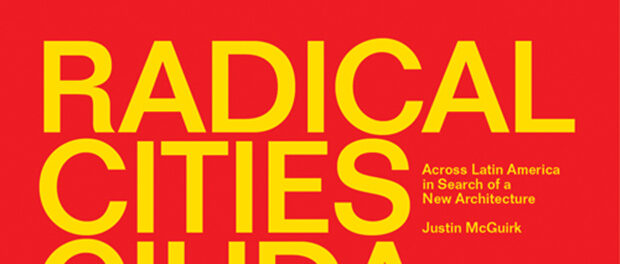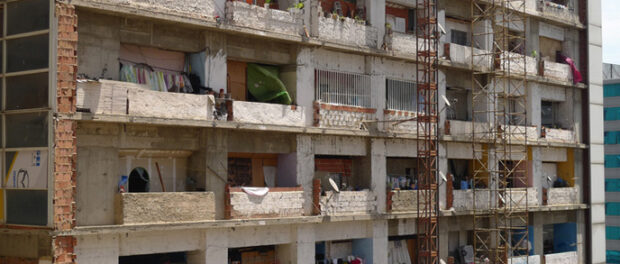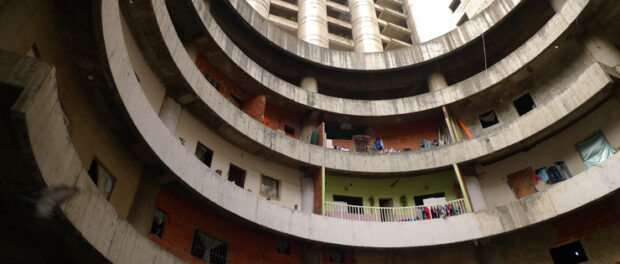
In his book Radical Cities: Across Latin America in Search of a New Architecture, art critic Justin McGuirk takes readers on a ride across the physical and social landscapes of urban Latin America, criss-crossing the continent, centralizing exceptional stories of urban innovation.
The ride starts in Túpac Amaru, a housing collective in Argentina. McGuirk then makes his way north, analyzing government intervention and public housing in Lima, Peru, and Santiago, Chile; favelas, informality and urban integration in Rio de Janeiro; and the politics of place at the famous Torre David in Caracas, Venezuela. He takes a long pause in Colombia, celebrating accounts of creative urban revitalization in Bogotá and Medellín. Finally, readers are left at what McGuirk calls the ‘political equator,’ where the logistics of transnational metropolitan spaces and the environmental ties between subdivisions in San Diego, USA, and colonias in Tijuana, Mexico, complicate an already tense relationship.
Through these stories, McGuirk tells the contemporary urban history of Latin America, highlighting the movement away from the modernist utopias that were pursued (often under military rule), using mass social housing as a tool for evictions and relocations, towards a more sensitive, place-based style of urban development, coined “urban acupuncture.” Indeed, there were economic and political factors that favored this change, including the recognition of the failures of modernist mega-projects and the embrace of neoliberalism. In Radical Cities, McGuirk highlights the contributions of individuals responsible for this new approach to urban planning, acknowledging a new, albeit small generation of architects, organizers and politicians who have taken on the role of “idealistic pragmatists,” for whom an understanding of favelas as solutions is at the core of their work.
Empirically, it makes sense to address and adapt to informality rather than to ignore it. In highly urbanized Latin America, one third of all city dwellers live in informal conditions. McGuirk complements this well-known statistic with another: the fact that 85% of housing worldwide is built illegally. This makes residents of informal settlements the primary developers of urban spaces, dictating the design and use of more square miles than architects and governments. With this in mind, McGuirk poses two questions: “When will we come to terms with the fact that the favelas are not a problem of urbanity, but the solution? And, when will we accept that the favela is the city?”

The history of Torre David in Venezuela is certainly emblematic of the union between informal settlements and the city. It is an unfinished 42-story tower in downtown Caracas that was initially destined to be prime commercial real estate. When developer David Brillembourg passed away and finances dried up, the building sat half-built and unoccupied until a group of individuals in Caracas occupied the building in 2007 and revolutionized its use. Since then, roughly three thousand people have called Torre David home. Urban Think Tank, a group of architects from Venezuela, have been instrumental in documenting and exhibiting the unique model–an informally occupied skyscraper–even showcasing the building at the Venice Biennale in 2012. Like many, McGuirk is fascinated by the building, referring to it as a “pirate utopia,” in which residents overcame impossible conditions to create a home and a community.
Interestingly, in the chapter on Rio de Janeiro entitled “The Favela is the City,” McGuirk does not focus on one architect or project, but recounts the origins and history of favelas in Rio, discussing the wide range of policies and programs that have turned the city into somewhat of a living urban laboratory. Concerned with the integration of the favela, McGuirk comments on pacification programs, Favela Bairro, and the unique, yet misguided, task of planning for mega-events.
While certain recent developments in Rio could be characterized as urban acupuncture, incorporating new and emerging innovations, McGuirk does acknowledge that evictions and mass housing production, the old tools of the trade in “dealing with” favelas, are still practiced in Brazil and throughout Latin America. The re-emergence of distant mass-produced social housing in Brazil through the program Minha Casa Minha Vida, with over two million housing units built since 2009, represents the antithesis of his proposal for urban acupuncture.
The tension between competing approaches to government intervention and the feasibility of a more sensitive approach is acutely visible last week as news broke that the government of Caracas has begun evictions at Torre David. In even more despairing news, it was revealed that the structure has been slated for demolition. Families will be moved to a new social housing project roughly an hour out of the city center. This action threatens to erase the rich urban social history that emerged since the 2007 occupation. The unfortunate irony is that while McGuirk explored the potential replicability of a Torre David-esque model in order to challenge the market-driven status quo in which the urban poor are pushed to spontaneous settlements on the periphery while buildings sit idle and empty in the city center, the government and private developers had other plans.
Despite McGuirk’s celebration of the informal, his analysis favors the creativity and charisma of architects, politicians and organizers, who are celebrated for accomplishing big innovations on small(er) budgets, over the discrete actions by individuals responsible for building the informal city. In doing so, the author risks undermining the adaptive capacity of residents and communities to design and build locally. In actuality, the “radical” nature of Latin American cities highlighted in the book reflects a reconceptualization of architecture to directly engage with informality using scarce resources, instead of a new/radical understanding of who occupies or has a say in our urban future. Nevertheless, he positions the Latin American urban experience as relevant and exemplar on a global scale, per McGuirk: “accepting the informal city as an unavoidable feature of the urban condition, and not as a city-in-waiting, is the key lesson that this generation of Latin American architects can offer the world.”

